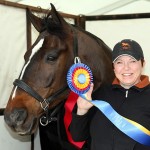
NO SECRET SO CLOSE is the story of a the most unthinkable betrayal humanly possible — at only 24 years old, Claire Dorotik’s father has been murdered, her mother arrested, and now, in a sinister twist of fate, Claire’s mother points the finger at Claire, accusing her of killing her own father. Battling the feelings of loss, abandonment, terror, and dissociation, and also learning about them, Claire struggles to stay in her master’s program for psychotherapy. However, when Claire’s brothers also betray her and side with her mother, Claire is left all alone to care for the 18 horses she and her mother owned. As the story unfolds, what is revealed is the horses’ amazing capacity for empathy in the face of human trauma, and the almost psychic ability to provide the author with what had been taken from her. Arising from these horrifying circumstances, the most unthinkable heroes — the horses — show Claire that life is still worth living.
Excerpt #27 from NO SECRET SO CLOSE:
I don’t think I’ll ever stop replaying that day in my mind. As if I could somehow make it come out differently. Makes no sense, of course, but I couldn’t stop the endless spooling of memory. If I could, I’d have to let go, I guess of wishing I could have prevented it.
I paid the toll and entered the 405 freeway headed for home looking down at the speedometer, I saw I was going too fast. I’d stayed longer than I wanted to at my aunt’s house, and it was getting late now. The weekend with her had helped clear my head as it always did. Lately I’d been too busy to think. Only one semester away from receiving my undergraduate degree, I was already two semesters into my graduate program. That’s just the way things were: Up at five a.m. to train clients at the gym three days a week, followed by a rushed car ride to school the five jumpers I was training before it was too dark to ride, then a quick run down to the lake and back home by nine p.m. The other two days were back-to-back classes.
Continue reading NO SECRET SO CLOSE excerpt #27, by Claire Dorotik




